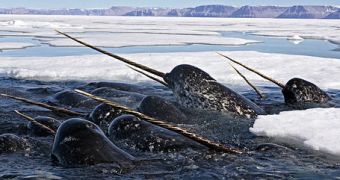The polar bear is indeed a more iconic animal than the narwhal and, on top of that, despite being classified as marine, we can see it mostly on land. This may explain why people have been focusing more on it than on other Arctic animals, when warning about the danger of extinction caused by global warming. With all this, a new research published in the Ecological Applications journal shows which species would be the first victim: the narwhal.
The narwhal is a cetacean with a long spiral tusk present only on the male - it is believed that it was this tusk that led to the creation of the myth of the unicorn in medieval times. (However, the legend could have also started from a species of rhino from Central Asia that, sadly, became extinct about 1,000 years ago.) During an 11-year survey, researchers from three countries assessed the vulnerabilities to increasing warming manifested by Arctic sea mammals. As far as the magnitude of the risk is concerned, the narwhal and polar bear were followed by the hooded seal, bowhead whale and walrus. Less menaced Arctic species were the ringed and the bearded seal.
"What we wanted to do was look at the whole picture because there's been a lot of attention on polar bears. We're talking about a whole ecosystem. We're talking about several different species that use ice extensively and are very vulnerable," said co-author Ian Stirling, a polar bear and seal specialist for the Canadian government.
The researchers focused on nine factors connected to the ability to resist climate changes, like population size, habitat uniqueness, diet diversity and degree of dependence on sea ice. The narwhal, a less studied species until now, has a current population of 50,000 to 80,000, while the polar bear, more dependent on ice, has a population of about 20,000.
"There could a bazillion of them, but if the habitat or the things that they need are not going to be around, they're not going to make it. Polar bears can adapt a bit to the changing Arctic climate, narwhals can't," said Stanford University biologist Terry Root.
"The narwhal, which dives about 6,000 feet (2,000 m) to feed on Greenland halibut, is the ultimate specialist, evolved specifically to live in small cracks in parts of the Arctic where it's 99% heavy ice," said lead author Kristin Laidre, a research scientist at the University of Washington.
The melting of the ice not only leaves the narwhal without its habitat, but it also gives free access to its most fearsome natural predators, the orca (the other predator being the polar bear). "Since it's so restricted to the migration routes it takes, it's restricted to what it eats, it makes it more vulnerable to the loss of those things," Laidre told LiveScience.
It is "surprising because the polar bear gets a lot of attention. Inuit (Eskimo) natives of Greenland were telling scientists last year that it seemed that the narwhal population was in trouble," explained Bob Corell, who led a massive assessment of risk in the Arctic in 2004.

 14 DAY TRIAL //
14 DAY TRIAL //